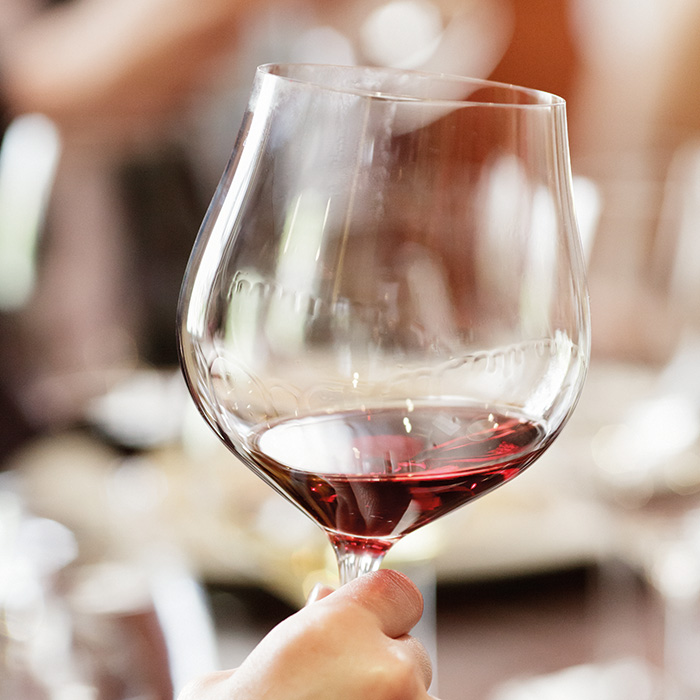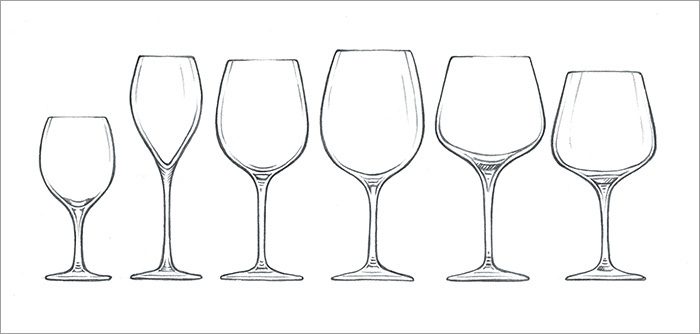A guide to glassware
Author: Berry Bros. & Rudd

Photograph: Jason Lowe
In any shop you’ll find a range of glasses for wine: larger, smaller, taller, narrower…. There are good reasons for this diversity of shapes; but whether or not you want to invest in a complete range, here are the things to look out for in any glass, whether everyday or expensive.
First, look for clear glass: avoid colours, patterns or heavy engraving. You’ll want to be able to look at, and enjoy, the colour and density of your wine.
Next, look for a ‘tulip’ shape, with the top curving inwards to the rim: this will help concentrate the aromas for you to inhale. Shape is important, too, for sparkling wines: the tall, narrow ‘flute’ stops the bubbles escaping too fast. The old-fashioned saucer-shaped glass may be fun, but your fizz will go flat faster.
Another good tip when buying inexpensive glasses for everyday use is to look for a fairly thin rim: for some reason, this makes the wine taste better. (Hence, too, glass: wine doesn’t taste the same out of china, or pottery, or plastic – nor, indeed, out of silver or gold!)
Sadly, even the best dishwasher will eventually dull and scratch glassware. Good glasses should never be machine-washed. Ever. And if you do succumb to dishwashing the more everyday glasses (on the lowest temperature), please rinse them in fresh hot water to ensure your precious wine is not tainted by any rinse-aid residue.
Rinsing is an important tool, whatever the glass. Even hand-washed and -dried ones can pick up smells if stored in a cardboard box, or upside-down in a cupboard (don’t). So rinse, dry quickly with a lint-free cloth – or at least air and polish them – before a meal or a tasting with good wines.
Decanters present a particular problem: rinsing out quickly after use will stop them staining (people have been known to resort to denture-cleaning tablets, then lots and lots of rinsing, when this has been overlooked…). But drying requires care: they are difficult to stand upside-down. You can buy special decanter-drying racks; or ‘decanter socks’ full of water-absorbing crystals are helpful. Wedging them neckdown between the slats of a clothes-drying cupboard if you have one also works. Wide-necked carafes or glass jugs are more practical day to day. Note: store decanters without the stopper in. As with glasses stored upside down, stale air can leave a taint.
Size: A glass ought to be large enough to take a sensible amount of wine – perhaps a sixth or an eighth of a bottle – without being more than a quarter or a third full.
To summarise, better a pool of wine in a big glass than brimful in a small one.
The reasons: to allow you to swirl the wine around, releasing its aromas and flavours, and to let you sniff the wine with the glass around it, funnelling the aromas up to your nose.

Size aside, many different shapes exist. The only essential is a slightly in-turned rim. Scholars (some call them fanatics) and glass manufacturers believe that there is a ‘correct’ shape for every last style of wine. This leads to glasses for young red Burgundy, and different ones for mature red Burgundy, a third type for Tuscan reds…. And so on. For most of us, a range like the one opposite provides ample scope.
In practice, most people begin with three basic shapes:
- A tall ‘flute’ for sparkling wine, designed to show off the bubbles to best effect.
- A larger glass, with a more pronounced bowl, for red wines. This gives room for the wine to emit its aromas, and as temperature-change is less of a concern than with whites, the red-wine glass can be bigger.
- A moderate-sized glass for white wines,which can be smaller than its red partner because we tend to serve smaller servings of whites to avoid the wine warming up in the glass. Also we are less in search of mature aromas, and thus less inclined to swirl, than with reds.
The examples shown above are glasses designed by Berry Bros. & Rudd, reflecting three centuries of experience of what gives most pleasure. The current range has evolved from that designed by Francis Berry in 1931.
The glasses are named for benchmark styles of wine. Wines made from the same grapes, and/or in the same styles, as the benchmark wines, will work well in them. Thus a Cabernet Sauvignon will taste good from the red Bordeaux glass, as will Rhône reds. For a Pinot Noir or, say, Italian reds, the red Burgundy glass is designed to accentuate aromas.
Young white wines and aromatic styles suit the white Bordeaux glass, which is shaped to stress fruit, aromas and elegance. The wider bowl of the white Burgundy glass works well with all Chardonnay-based wines and with other rich white styles, such as those from the Rhône or Rioja.
Browse our range of glassware, The Wine Merchant’s Glasses, on bbr.com.


